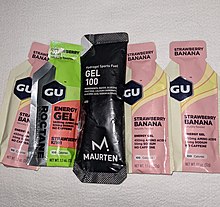Energy gelsare ediblecarbohydrategels that provide energy for exercise and promote recovery,[1]commonly used in endurance events such asrunning,cycling,andtriathlons.Energy gels are also referred to as endurance gels, sports gels, nutritional gels, and carbohydrate gels.[1]

Energy gels are packaged in small, single-serve plastic packets. Each packet has a strip with a small notch at the top that can be peeled off to reveal an opening through which the gel can be consumed. One-handed operation is often adopted by users to facilitate continuous exercise performance.
Packaging and ingredients
editThe size content of energy gels is commonly 1.2 oz (32g), with a range from 1 oz to 1.5 oz packets. The portable packaging is designed to facilitate uninterrupted training or performance conditions.[2]Common ingredients include water,maltodextrin,fructose,and variousmicronutrients,preservatives,and flavor compounds orcaffeine.[2]
History
editSports energy gels emerged in the United Kingdom in 1986 as a "convenient, prewrapped, portable" way to delivercarbohydratesduring endurance events.[3]Gels have a gooey texture and are sometimes referred to as "goo" generically.[4][5]The gel Leppin Squeezy was distributed at the HawaiiIronman Triathlonin 1988. Once considered a "cult product in clear packaging", energy gel products are now marketed in fancy packaging[6]and come in a variety of flavors.[3]The energy gel market grew during the 1990s, as professional athletes began endorsing products. Manufacturers generally encourage the consumption of multiple packets, with water, when participating in endurance events.[3]
Use
editEnergy gels are promoted to individuals seeking a boost from caffeine and carbohydrates during exercise performance.[7][8]The recommended use of an energy gel is 15 minutes before starting and 30–45 minutes after starting the endurance exercise.[1]
Taste
editEnergy gels have varied taste by addition of flavor ingredients added during manufacturing, such asmentholandchailatte.[9][10]
See also
editReferences
edit- ^abcEnergy gel for running - how to use, ingredients and selection
- ^ab"GU Energy Gel - Nutrition / Ingredients".GU Energy New Zealand.Retrieved9 December2021.
- ^abcSchwarb, John (January 3, 2003)."Forget carb-filled bars, runners gaga for goo".St. Petersburg Times.St. Petersburg, Florida.RetrievedJanuary 13,2014.
- ^Gallman, Judith M."Brian Vaughan: GU Guru".Oakland Magazine.Archived fromthe originalon February 22, 2014.RetrievedFebruary 11,2014.
- ^Blake, Judith (November 19, 2004)."A new fuel for athletes: energy gels".The Baltimore Sun.Tribune Company.ISSN1930-8965.Archived fromthe originalon February 22, 2014.RetrievedJanuary 23,2014.
- ^"The Energy Bomb - Chocolate honey for energy, focus, stamina".Zang.Retrieved2023-02-20.
- ^Fukuda, David H.; Smith, Abbie E.; Kendall, Kristina L.; Stout, Jeffrey R. (1 September 2010)."The possible combinatory effects of acute consumption of caffeine, creatine, and amino acids on the improvement of anaerobic running performance in humans".Nutrition Research.30(9): 607–614.doi:10.1016/j.nutres.2010.09.004.PMID20934602.Retrieved9 December2021.
- ^"As Olympians Suck Down Energy Gels, A Believer In 'GU' Gel Seeks Reality Check".www.wbur.org.5 August 2016.Retrieved9 December2021.
- ^Stevens, Christopher J.; Ross, Megan L. R.; Vogel, Roxanne M. (27 November 2020)."Development of a" Cooling "Menthol Energy Gel for Endurance Athletes: Effect of Menthol Concentration on Acceptability and Preferences".International Journal of Sport Nutrition and Exercise Metabolism.31(1): 40–45.doi:10.1123/ijsnem.2020-0190.PMID33248439.S2CID227218991.Retrieved9 December2021.
- ^Taylor, Tom."How GU Energy creates its flavors in a lab".Sports Illustrated.Retrieved9 December2021.